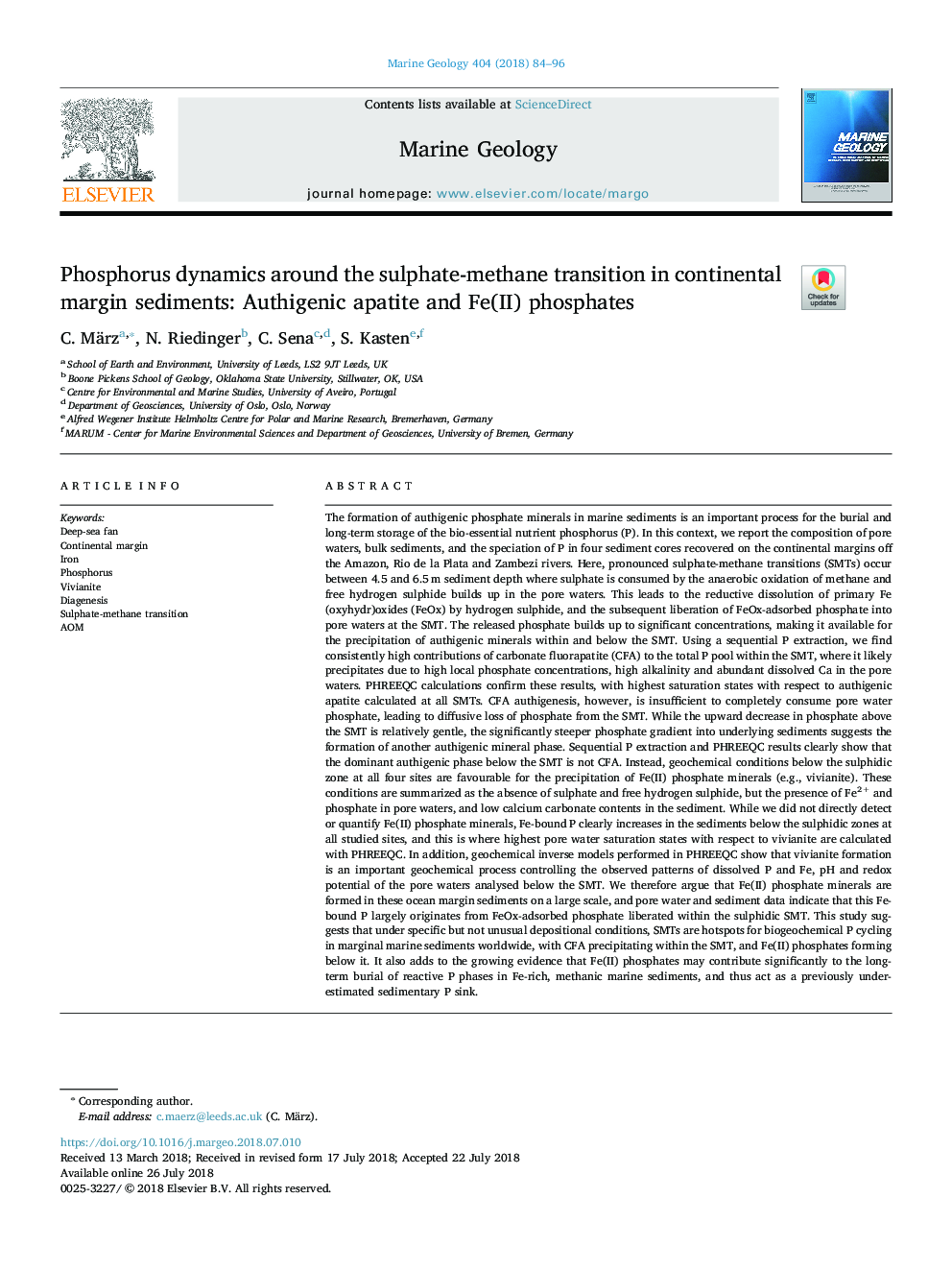| کد مقاله | کد نشریه | سال انتشار | مقاله انگلیسی | نسخه تمام متن |
|---|---|---|---|---|
| 8911904 | 1639048 | 2018 | 13 صفحه PDF | دانلود رایگان |
عنوان انگلیسی مقاله ISI
Phosphorus dynamics around the sulphate-methane transition in continental margin sediments: Authigenic apatite and Fe(II) phosphates
دانلود مقاله + سفارش ترجمه
دانلود مقاله ISI انگلیسی
رایگان برای ایرانیان
کلمات کلیدی
موضوعات مرتبط
مهندسی و علوم پایه
علوم زمین و سیارات
ژئوشیمی و پترولوژی
پیش نمایش صفحه اول مقاله

چکیده انگلیسی
The formation of authigenic phosphate minerals in marine sediments is an important process for the burial and long-term storage of the bio-essential nutrient phosphorus (P). In this context, we report the composition of pore waters, bulk sediments, and the speciation of P in four sediment cores recovered on the continental margins off the Amazon, Rio de la Plata and Zambezi rivers. Here, pronounced sulphate-methane transitions (SMTs) occur between 4.5 and 6.5â¯m sediment depth where sulphate is consumed by the anaerobic oxidation of methane and free hydrogen sulphide builds up in the pore waters. This leads to the reductive dissolution of primary Fe (oxyhydr)oxides (FeOx) by hydrogen sulphide, and the subsequent liberation of FeOx-adsorbed phosphate into pore waters at the SMT. The released phosphate builds up to significant concentrations, making it available for the precipitation of authigenic minerals within and below the SMT. Using a sequential P extraction, we find consistently high contributions of carbonate fluorapatite (CFA) to the total P pool within the SMT, where it likely precipitates due to high local phosphate concentrations, high alkalinity and abundant dissolved Ca in the pore waters. PHREEQC calculations confirm these results, with highest saturation states with respect to authigenic apatite calculated at all SMTs. CFA authigenesis, however, is insufficient to completely consume pore water phosphate, leading to diffusive loss of phosphate from the SMT. While the upward decrease in phosphate above the SMT is relatively gentle, the significantly steeper phosphate gradient into underlying sediments suggests the formation of another authigenic mineral phase. Sequential P extraction and PHREEQC results clearly show that the dominant authigenic phase below the SMT is not CFA. Instead, geochemical conditions below the sulphidic zone at all four sites are favourable for the precipitation of Fe(II) phosphate minerals (e.g., vivianite). These conditions are summarized as the absence of sulphate and free hydrogen sulphide, but the presence of Fe2+ and phosphate in pore waters, and low calcium carbonate contents in the sediment. While we did not directly detect or quantify Fe(II) phosphate minerals, Fe-bound P clearly increases in the sediments below the sulphidic zones at all studied sites, and this is where highest pore water saturation states with respect to vivianite are calculated with PHREEQC. In addition, geochemical inverse models performed in PHREEQC show that vivianite formation is an important geochemical process controlling the observed patterns of dissolved P and Fe, pH and redox potential of the pore waters analysed below the SMT. We therefore argue that Fe(II) phosphate minerals are formed in these ocean margin sediments on a large scale, and pore water and sediment data indicate that this Fe-bound P largely originates from FeOx-adsorbed phosphate liberated within the sulphidic SMT. This study suggests that under specific but not unusual depositional conditions, SMTs are hotspots for biogeochemical P cycling in marginal marine sediments worldwide, with CFA precipitating within the SMT, and Fe(II) phosphates forming below it. It also adds to the growing evidence that Fe(II) phosphates may contribute significantly to the long-term burial of reactive P phases in Fe-rich, methanic marine sediments, and thus act as a previously underestimated sedimentary P sink.
ناشر
Database: Elsevier - ScienceDirect (ساینس دایرکت)
Journal: Marine Geology - Volume 404, 1 October 2018, Pages 84-96
Journal: Marine Geology - Volume 404, 1 October 2018, Pages 84-96
نویسندگان
C. März, N. Riedinger, C. Sena, S. Kasten,